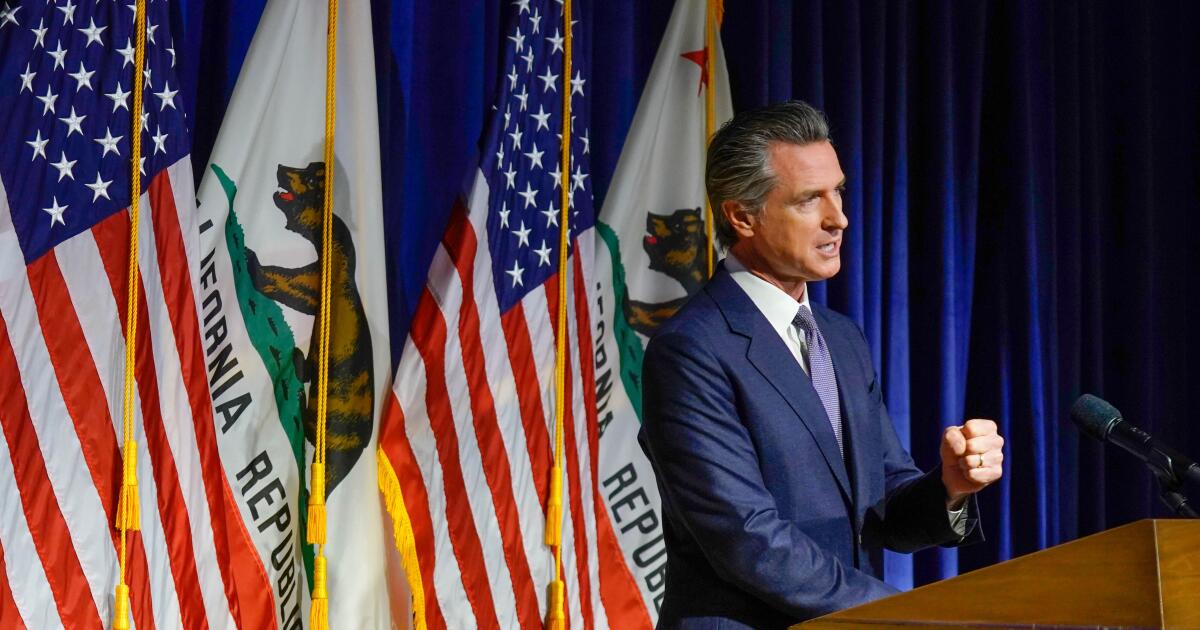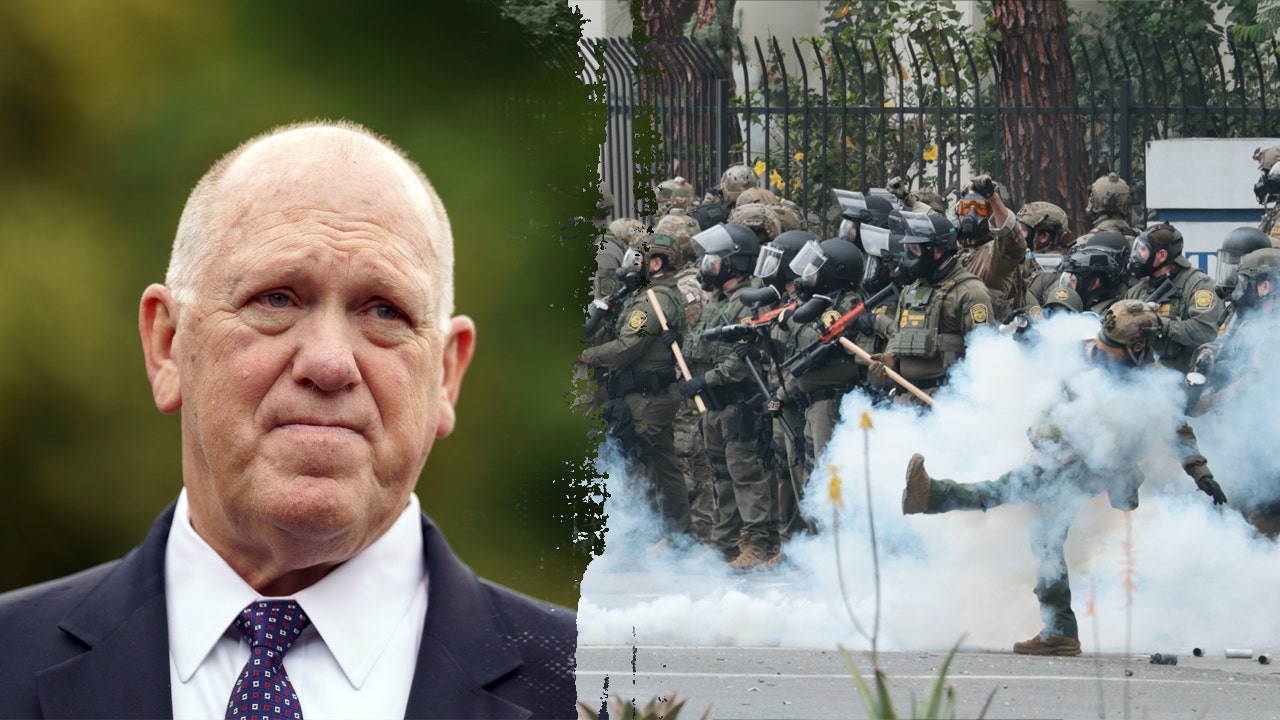Politics
Public defenders, foster kids, climate: Programs created during California's boom may stall amid deficit

Just a few years ago, California’s budget was overflowing with a record high surplus, spurring the creation of a slew of programs reflecting the state’s liberal ideals.
Democrats who control the state Capitol funded pilots to test new ways to support foster youth, help oil workers transition to cleaner industries and prevent more Californians from becoming homeless — just some of the ambitious ideas that became reality when the budget was flush.
Now, as the state faces an enormous budget deficit that the nonpartisan Legislative Analyst’s Office predicted in February could be as much as $73 billion, some of those programs could come to a screeching halt.
Gov. Gavin Newsom and Democratic lawmakers are considering significant cuts to some of the very initiatives they recently helped launch while promising to “protect our progress.”
It’s both a reflection of California’s wild budget fluctuations and what can happen in a one-party state known as a progressive policy trailblazer when financial times are good.
For Republicans, it’s an “I told you so” moment.
“The surpluses were absolutely abnormal. They should have put much more money into the budgetary reserve than they did,” said Sen. Roger Niello (R-Fair Oaks), vice chair of the Senate Budget Committee.
Newsom’s budget last year included record reserves of nearly $38 billion, but for those in the minority party like Niello, more could have been put away in lieu of creating costly new programs.
“Let’s not get too crazy with these huge revenues,” is the approach Democrats should have taken, Niello said.
Organizations such as the California Budget Policy Center, which advocates for low-income residents and policies that curb inequities, argue there’s nothing wrong with trying out new ideas when the money is there.
“The state needs these opportunities to experiment and practice innovation because you can improve the efficiency and effectiveness during those periods of time,” said Chris Hoene, executive director of the center. “The deficit is forcing them to pull back on a significant share of programs but … if there are better revenue periods ahead, they have said they will continue to make those investments.”
Reducing or altogether eliminating newer programs that are still being tested is better than cutting long established programs that Californians rely on, said H.D. Palmer, a spokesperson for Newsom’s Department of Finance.
“These clearly are proposals that wouldn’t be put forward were [it] not for the fact that we’ve got a substantial shortfall,” Palmer said. “It is understandable that people would have objections to these proposals. The question then becomes: What alternatives would people want to put forward, if you choose not to do these measures, that would provide us a like amount of savings to close the shortfall?”
Sen. Dave Min (D-Irvine) put it more bluntly during a legislative budget meeting held at the Capitol last week: “I’ll just be honest, this sucks.”
Newsom signed into law this week a budget agreement made with lawmakers that reduces the deficit by $17 billion, though it’s only a first step toward closing the yawning gap in the state’s spending plan.
As negotiations continue leading up to the June 15 deadline for lawmakers to pass a budget, here are some of the pilot programs Newsom has suggested scaling back or eliminating:
Support for public defenders and eligible prisoners
Prisoners who can’t afford to pay private attorneys and are eligible to have their sentences shortened could potentially stay behind bars longer due to one proposed funding reduction.
In 2021, a public defense pilot program was created to help attorneys cope with a backlog of cases involving prisoners eligible for earlier release under the state’s latest progressive resentencing laws.
Under the program, county public defender offices have received $100 million, collectively helping free more than 8,000 people in the program’s first six months, according to the California Board of State and Community Corrections. Many of those beneficiaries were charged with murder because of their involvement in a felony that led to a death, even if they were not the actual killer — a remnant of a law that California overturned in 2019.
The program now faces a $40-million reduction — a move proponents say could render some of California’s resentencing laws useless because understaffed and overburdened offices won’t be able to adequately assist those eligible.
A representative for Newsom said the funding given so far “still provides data for the evaluation of the results” of the program. But Ricardo Garcia, public defender for Los Angeles County, says it will hamper the state’s efforts to “right some of the mistakes of the past.”
In Los Angeles County, the program has led to the release of more than 100 prisoners, representing 685 fewer years of total potential incarceration, according to Garcia. The program has allowed Garcia’s office to hire more public defenders, social workers and support staff as they represent more than 800 eligible clients who await resentencing.
“Having all these statutes in place … isn’t very helpful if we don’t have the resources to implement it and to really make them effective,” Garcia said.
Help for struggling foster kids
Since 2019, thousands of foster kids — and some of their caretakers — have been able to call a 24/7 hotline for help with everyday conflicts and receive expert support.
The urgent response system was prompted by concerns about “placement disruptions” that can lead to instability and possibly homelessness for the already vulnerable youths.
The hotline annually serves about 5,000 foster children and caregivers, according to state data.
Child welfare advocates are calling on the governor and lawmakers to reconsider a $30-million proposed reduction — a cut they say will shutter the program entirely.
Foster placement changes in California decreased by 16% since the launch of the hotline, according to the data, and advocates say that’s no coincidence.
“We’re certain cutting it will lead to serious negative outcomes for foster children, including increased hospitalization and criminalization,” Ted Lempert, president of Children Now, said.
Funding for low-income housing
In 2023 alone, more than 100,000 Californians had to move because the owners of their homes fell behind on their bills, according to the Community Landtrust Network.
The foreclosure intervention housing preservation program was launched as a way to prevent displacement of renters. It offers grants to residents and nonprofits so they can buy properties at risk of foreclosure and keep them available as homes for people with low incomes.
Proponents of the program called it an “unprecedented” solution to the state’s homelessness crisis because it allows at-risk renters to stay where they are instead of potentially being forced onto the streets or into shelters.
Newsom proposed cutting $248 million meant for the program over three years — about half its total budget. Advocates are urging him to change his mind, as the funding has not even yet been disbursed.
“The need for the program is too great and both [the California Department of Housing & Community Development] and other key stakeholders have sunk too many resources into this pioneering housing strategy to hobble it now,” the Community Landtrust Network said in a statement.
A slew of climate friendly programs
Low-income Californians at the highest risk of wildfires destroying their homes, and oil and gas workers at risk of losing their jobs, are among those who could feel the brunt of climate programs now on the chopping block.
Funding reductions are proposed for a home hardening initiative, a program that helps workers find new jobs as the state moves away from fossil fuels, and a program that promotes composting in local governments.
The proposed reductions have environmental activists concerned, even as the budget draft maintains billions in investments to curb climate change and California is considered an international leader on the issue.
“The state needs to accelerate its efforts to prepare, not pull back — especially in vulnerable and underresourced communities,” Zack Cefalu, a legislative affairs analyst for the League of California Cities, said.

Politics
Posse Comitatus Act at center of Trump-Newsom National Guard dispute in LA

NEWYou can now listen to Fox News articles!
President Donald Trump and California Gov. Gavin Newsom are clashing over the deployment of the National Guard amid ongoing Los Angeles riots with different interpretations of the 1878 law that governs the use of the military to enforce the law domestically.
The Posse Comitatus Act was signed into law by President Rutherford B. Hayes amid concerns that the military had too much sway over civilian affairs during Reconstruction. It generally bars the use of the U.S. military for civilian law enforcement inside the country, but there are key exceptions. Trump deployed the National Guard early Sunday, but so far, those troops have not participated in any direct law enforcement.
JOHNSON SAYS HEGSETH POSSIBLY SENDING MARINES TO ANTI-ICE RIOTS NOT HEAVY-HANDED: ‘DETERRING EFFECT’
Trump sent in the National Guard after Immigration and Customs Enforcement agents were reportedly attacked on the streets of L.A. as they conducted raids to catch and deport illegal immigrants. Seeing that neither Newsom nor L.A. Mayor Karen Bass were moving aggressively enough to stop the attacks, Trump signed a presidential memorandum to deploy 2,000 National Guard troops to “address the lawlessness that has been allowed to fester,” the White House said in a statement.
Demonstrators block the highway as law enforcement officers face them during a protest against federal immigration sweeps in Los Angeles on June 8, 2025. (REUTERS/Mike Blake)
Newsom objected immediately even as the riots spiraled.
“I have formally requested the Trump Administration rescind their unlawful deployment of troops in Los Angeles county and return them to my command,” Newsom wrote on X on Sunday alongside his letter to President Trump. “We didn’t have a problem until Trump got involved. This is a serious breach of state sovereignty – inflaming tensions while pulling resources from where they’re actually needed.”
In addition to the Guard, the Pentagon said Sunday night it stands ready to send in 500 active-duty Marines.
If the military is to take an active role in suppressing the riots, the 147-year-old law will take center stage. Exceptions to the Posse Comitatus Act that allow the military to enforce the law against U.S. citizens include congressional decree, if an insurrection has been declared under the Insurrection Act, or when state governments prove unable or unwilling to impose law and order.
Politics
National Guard arrives in Los Angeles as fallout from immigration raids continues

California National Guard troops arrived in Los Angeles on Sunday in a show of force following scattered clashes between immigration agents and protesters and amid a widening political divide between California and the Trump administration.
The move by President Trump to activate nearly 2,000 guardsmen marked the first time since 1965 that a president has deployed a state’s National Guard without a request from that state’s governor. The decision was met with stern rebukes from state and local officials, including Gov. Gavin Newsom who said the deployment was “not to meet an unmet need, but to manufacture a crisis.”
Newsom’s office on Sunday afternoon sent a formal letter to the Trump administration asking them to rescind their deployment of troops.
“There is currently no need for the National Guard to be deployed in Los Angeles, and to do so in this unlawful manner and for such a lengthy period is a serious breach of state sovereignty that seems intentionally designed to inflame the situation, while simultaneously depriving the state from deploying these personnel and resources where they are truly required,” the letter reads.
On Sunday afternoon, there were tense moments outside a federal detention center in downtown L.A., with officers firing tear gas and less-lethal rounds at protesters.
Around 4 p.m., a swarm of protesters streamed onto the southbound side of the 101 Freeway, blocking traffic. The protesters were in a standoff with dozens of officers lined up under the Los Angeles Street bridge.
But other areas that had seen unrest over the last few days, including the Garment District, Paramount and Compton, seemed calm.
It was unclear exactly how many troops were deployed to Los Angeles as of Sunday afternoon. The National Guard’s 79th Infantry Brigade Combat Team, based in San Diego, said Sunday that 300 personnel were on the ground to protect federal property and personnel.
Trump administration officials have seized on the isolated incidents of violence to suggest wide parts of L.A. are out of control. On Sunday, Trump took to social media to claim “violent, insurrectionist mobs are swarming and attacking” federal law enforcement.
“A once great American City, Los Angeles, has been invaded and occupied by Illegal Aliens and Criminals,” he wrote, blaming Democratic politicians for not cracking down earlier.
While officials have not said how long the immigration enforcement actions will continue, Trump told reporters Sunday, “we’re going to have troops everywhere. We’re not going to let this happen to our country.”
Many California officials, who have long been at odds with Trump, say the president was trying to exploit the situation for his political advantage and sow unneeded disorder and confusion.
Los Angeles Mayor Karen Bass called the deployment of federalized troops a “chaotic escalation” and issued a reminder that “Los Angeles will always stand with everyone who calls our city home.”
While most demonstrators have gathered peacefully, some have hurled objects at law enforcement personnel, set garbage and vehicles on fire and defaced federal property with graffiti.
The Immigration and Customs Enforcement operation in Los Angeles over the past week has resulted in the arrest of 118 people, including some who have been convicted of drug trafficking, assault, child cruelty, domestic violence and robbery, according to the agency.
Assistant Secretary for Public Affairs Tricia McLaughlin and Republican politicians who support Trump’s immigration actions have characterized the protests as riots intended to “keep rapists, murderers and other violent criminals loose on Los Angeles streets.”
Representative Maxine Waters speak to the media at the Metropolitan Detention Center in Los Angeles on Sunday.
(Jason Armond/Los Angeles Times)
On Sunday morning, Rep. Maxine Waters (D-Los Angeles) addressed roughly two dozen National Guard soldiers posted outside the Metropolitan Detention Center on Alameda Street. She had arrived at the center to inquire about Service Employees International Union California President David Huerta, who was injured and detained while documenting an immigration enforcement raid in downtown Los Angeles on Friday.
“Who are you going to shoot?” Waters asked the solders. “If you’re going to shoot me, you better shoot straight.”
Remnants of tear gas used by law enforcement during protests Saturday lingered in the air around the building, at times forcing Waters to cough. Waters, an outspoken critic of the president, called the deployment of National Guard troops an unnecessary escalation of tensions and accused Trump of “trying to make an example” out of Los Angeles, a longstanding sanctuary city.
Leonard Tunstad, a 69-year-old Los Angeles resident, rode his bike up to the edge of the loading dock where troops were stationed and asked them if they really wanted to be loyal to a president that “had 34 felony convictions.” He said he felt compelled to shout facts about Trump at the guardsmen because he feared the young men have been “indoctrinated against their own citizens.”
Tunstad said he believed the deployment was a gross overreaction by the Trump administration, noting the city has been home to far more raucous protests that were handled by local police.
“This is just a show. This is just a spectacle,” he said.
A Department of Homeland Security officer approached one of the louder demonstrators saying that he “didn’t want a repeat of last night” and didn’t want to “get political.” He told protesters as long as they stick to the sidewalk and don’t block vehicle access to the loading dock there wouldn’t be any problems.
Later, DHS and California National Guard troops shoved dozens of protesters into Alameda Street, hitting people with riot shields, firing pellets into the ground and deploying tear gas to clear a path for a caravan of DHS, Border Patrol and military vehicles to enter the detention center.
Jose Longoria struggled to breathe as clouds of tear gas filled Alameda Street. He pointed to a white scuff mark on his shoe, saying that a tear gas canister had hit him in the foot, causing him to limp slightly.
“We’re not armed. We’re just peacefully protesting. They’re acting out,” Longoria said of the officers.
Julie Solis, 50, walked back and forth along Alameda Street holding a Mexican flag and urging the crowd to make their voices heard, but to keep the scene peaceful. She said she believes the National Guard was deployed solely to provoke a response and make Los Angeles look unruly to justify further aggression from federal law enforcement.

People march toward the Metropolitan Detention Center during an immigration march in downtown Los Angeles on Sunday.
(Luke Johnson/Los Angeles Times)
“They want arrests. They want to see us fail. We need to be peaceful. We need to be eloquent,” she said.
National Guard troops were last summoned to Los Angeles and other Southern California cities in 2020, during the George Floyd protests. Those deployments were authorized by Newsom.
However, the last time the National Guard was called on by a president without a request from a state governor was 60 years ago, when President Lyndon B. Johnson sent troops to Alabama to protect civil rights demonstrators.
Antonio Villaraigosa, former speaker of the California Assembly and a former L.A. mayor, said Trump’s move was “meant to incite more fear and chaos in our community.”
“Trump’s military-style mass deportation ICE raids in California have gone too far, tearing families apart and threatening public safety,” he said in a statement. “The raids at stores and workplaces are wrong, just as it’s wrong to separate families with raids at schools, graduations, and churches.”
In Paramount, a group of camouflaged National Guard troops were stationed in a business park with armored vehicles where a Department of Homeland Security office is located.
Jessica Juarez walked along Alondra Boulevard with a trash bag full of spent tear gas canisters on Sunday morning. Her voice grew hoarse as she helped a group of volunteers clean up after clashes between protesters and law enforcement the day before.
United States Attorney Bill Essayli told NBC in an interview that an officer suffered a broken wrist and others were injured by rocks and cement block pieces that were thrown at them during Saturday’s protest. He said it was “an extremely violent crowd,” but officials are “undeterred.”
An acrid odor still hung in the air from the gas and flash bang grenades law enforcement fired on protesters Saturday, while scorched asphalt marked the intersection outside a Home Depot where federal authorities had staged.
“I’m proud of our community, of the strength we showed,” said Juarez, 40. “It’s like they put so much fear into Paramount and for what? These guys didn’t even clean up after themselves.”
The images of Paramount shrouded in smoke and flanked by police in riot gear are unusual for this community of about 50,000 residents. In many ways, the city became the starting point for the escalating federal response.
“What else do you call it but an attack on Paramount and the people who live here?” said resident and union organizer Alejandro Maldonado. “People in the community were standing up to unjust immigration policies.”
For some, the fight between Los Angeles residents and the federal government is akin to David and Goliath. “It really does seem like they wanted to pick a fight with the little guy,” union organizer Ardelia Aldridge said.
Staff writers Seema Mehta, Rebecca Ellis and Brittny Mejia contributed to this report
Politics
Video: Why the U.S. Brought Back Kilmar Abrego Garcia

new video loaded: Why the U.S. Brought Back Kilmar Abrego Garcia
Kilmar Abrego Garcia, who was mistakenly deported to El Salvador, was flown back to the United States on Friday to face federal criminal charges. Devlin Barrett, who covers the Justice Department, explains the charges and what may come next for Garcia.
Recent episodes in Politics
-

 Politics1 week ago
Politics1 week agoMichelle Obama facing backlash over claim about women's reproductive health
-

 Technology1 week ago
Technology1 week agoOpenAI wants ChatGPT to be a ‘super assistant’ for every part of your life
-

 Movie Reviews1 week ago
Movie Reviews1 week agoThe Verdict Movie Review: When manipulation meets its match
-

 Technology1 week ago
Technology1 week agoWhy do SpaceX rockets keep exploding?
-

 West2 days ago
West2 days agoBattle over Space Command HQ location heats up as lawmakers press new Air Force secretary
-

 Finance1 week ago
Finance1 week agoHere's what will boost your feeling of financial well-being the most, researchers say
-

 World1 week ago
World1 week agoTwo killed in Russian attacks on Ukraine before possible talks in Turkiye
-

 News1 week ago
News1 week agoDepartment of Homeland Security lists sanctuary jurisdictions in Northern California














